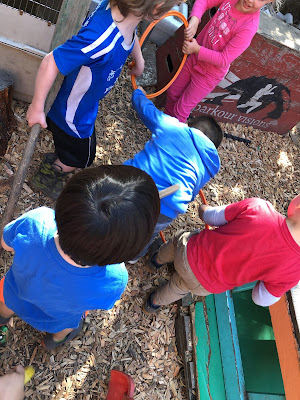One of the five-year-old boys in this, our final summer session, has sparked the imaginations of several of the younger boys. He is bold and inclusive, and enjoys taking the role as the authoritative (as opposed to authoritarian) leader. Several parents have told me that their kids talk of him at home, insisting that they are going to play with him, even if, in reality they spend their days watching from afar. Most of the games this glamorous boy organizes involve, at some level, rough housing or, if not that, pretend fighting of some sort, which can intimidate some of the younger kids, even as it also attracts them.
Yesterday, the game involved shooting one another with weapons devised from sticks and other longish items.
There was a time when I would have felt that it was incumbent upon me, the teacher, to be proactive about gun play, but the longer I've done this job, the more I'm inclined to not see it as a problem until the children themselves see it as a problem. At first, their game was fairly self-contained, with the older boy and his group of admirers mainly shooting at one another, but at one point they trained their sites on a three-year-old boy who had previously been part of their game, but who had, overwhelmed for a moment, opted out without telling them. He had a worried look on his face, so I asked him, "Do you like that they're shooting you?" He shook his head, so I drew attention to that by saying, "He doesn't like to be shot. He has a worried look on his face."

The younger boys kept shooting for a few seconds, my words not immediately registering, but the older boy stopped instantly, commanding, "Stop firing! We have to find some real criminals," which caused the others to imitate him. As they roved around the playground, the older boy orally weaving the story of the game they were playing, both commanding and cajoling, he served, in a way, as the group's pre-frontal cortex. He recalled that during the school year we had, as a class, agreed, that you must ask someone before you could shoot at them, and was enforcing it on his troops. Coming from him, it was far more effective than had I been trailing around after them with reminders.
At one point, their fierceness frightened another younger boy. Their leader, seeing the tears, lowered his weapon, bent down so they were face-to-face, put a hand on his shoulder, and said, "It's okay, we won't shoot at you. You're a good guy," then after a brief pause, added, "We're just pretending." This assurance calmed the boy almost instantly. Later, they frightened another boy, who I began to console. I was thinking the play was now beginning to show up as a problem and would need some intervention on my part, but the glamorous boy, apparently sharing my concern, announced in his best voice-of-god, "No more shooting! Now we have to march!" And that's what they did: march in a well-ordered line around the place in a noisy version of follow-the-leader. Later, one of them offered himself up as "the criminal" and they spent the rest of the morning, weapons abandoned, trying to take him to "jail."
I understand why we are so quick, as adults, to jump on weapon play of this sort. It smacks of violence and other societal problems. It sometimes frightens other children. We have had school years during which it was officially banned (by a consensus of the children), but that never prevented it from happening. It just gave us adults the right to step in and scuttle it, effectively pushing it "underground." I won't pretend to explain why, but I know that this sort of play emerges all over the world wherever children play in groups of any size. I know that there has never been a connection made between this sort of play and future violence: indeed, some research seems to indicate that children who are permitted to play these games are less likely to be violent adults. I know that dramatic play is how children process what they see in the world around them, how they come to understand it from all sides, and how it can become the foundation for empathy. I also know that forbidden fruit is always the sweetest: since I've stopped being so proactive about weapons play, instead treating it like all other sorts of play, I've definitely seen a drop in the amount of time and energy children spend on these games.
Yesterday was an exception in the sense that it rose to the level that it was beginning to frighten some of the other children. They took it to the edge, but they were, with the help of their leader, for the good of everyone, able to reign it back in. For me, that's the gold standard for playing in the world together.





